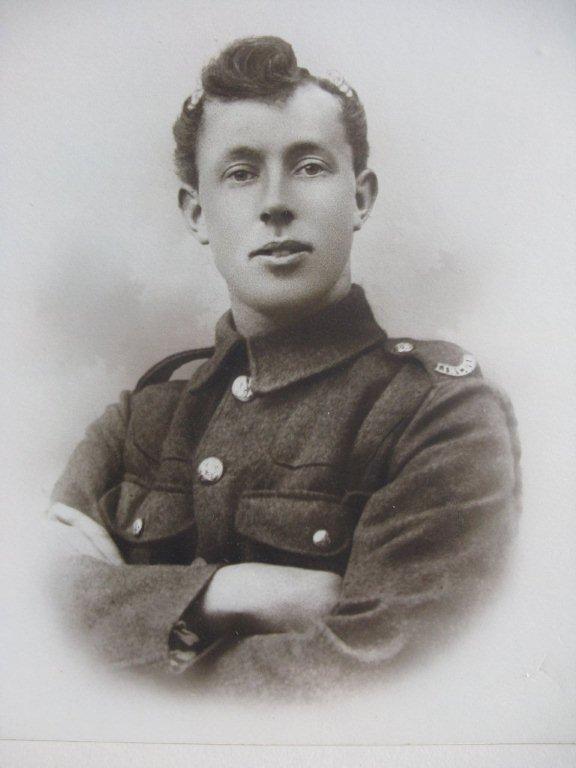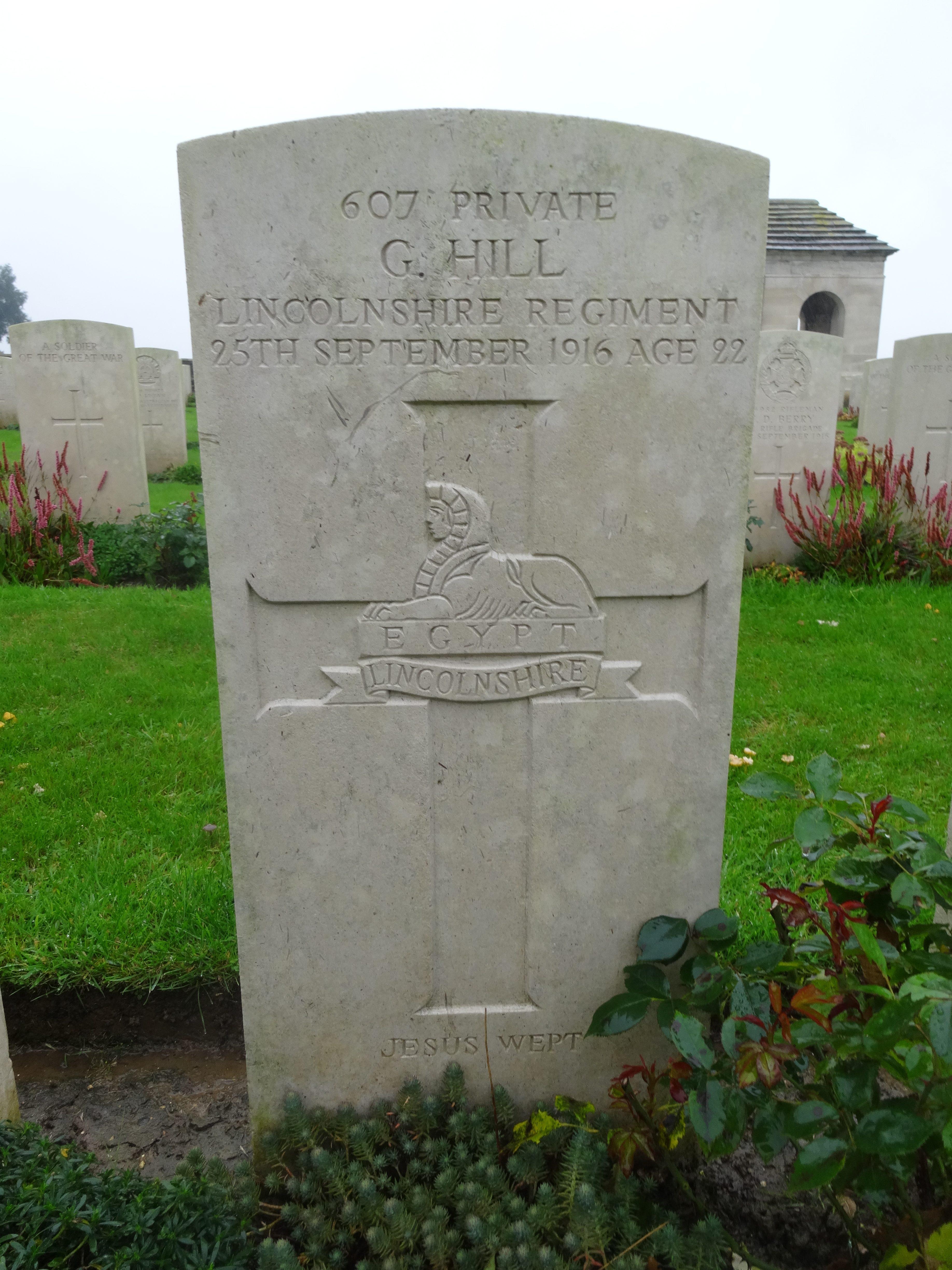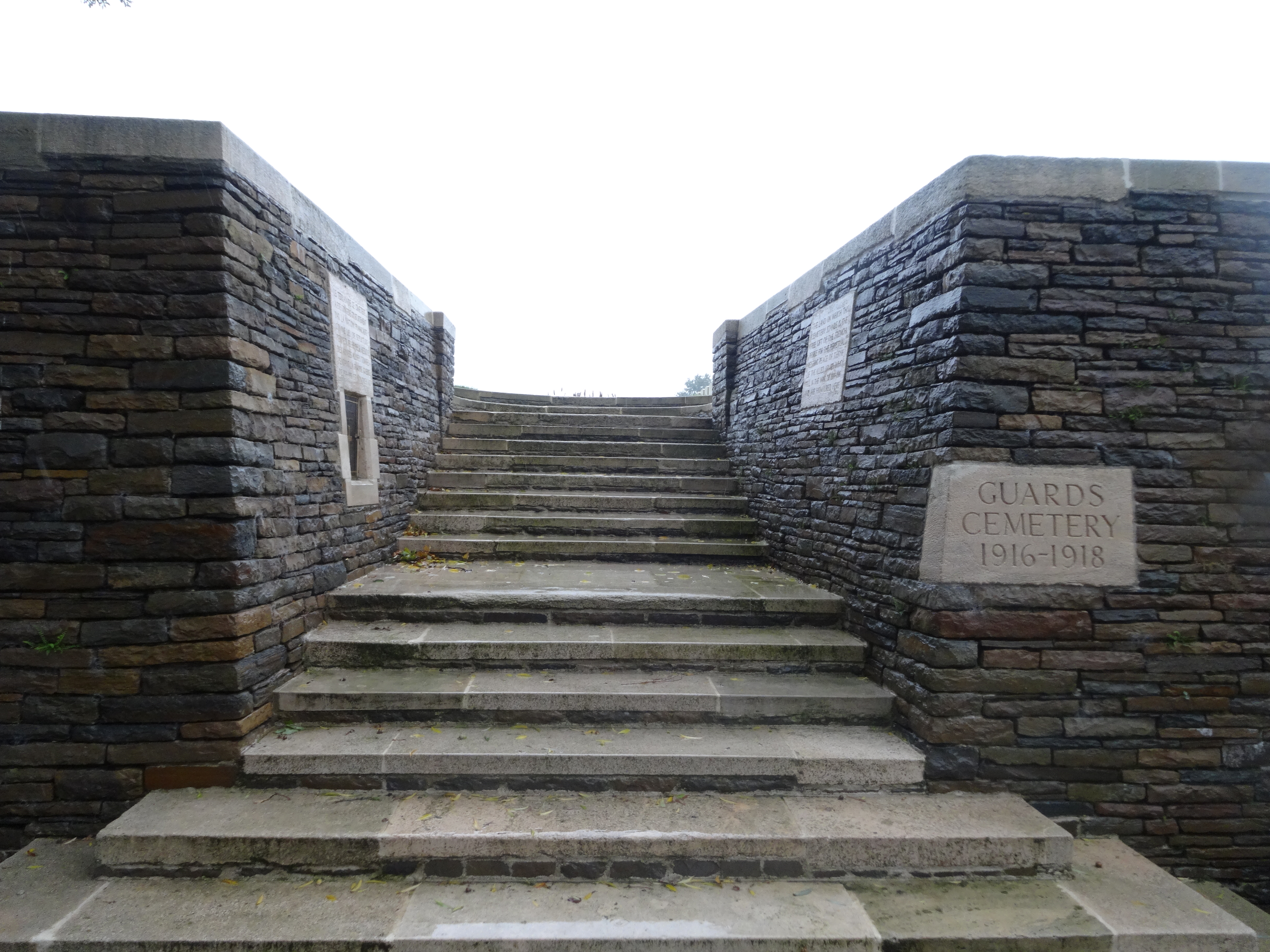Biography of Private George Hill (607)
10th Battalion Lincolnshire Regiment
Died 25th September 1916
Soldier
- Name: George Hill
- Date of birth: 1894
- Place of Birth: Rippingale, Lincolnshire, England
- Date of Birth registration: April – June 1894
- Place of Birth Registration: Bourne, Lincolnshire, England
Father
- Name: John Thomas Palmer Hill
- DOB: 1858
- Place of Birth: Rippingale, Lincolnshire, England
- Occupation: farm labourer
Mother
- Name: Annie Lizzie Musson
- DOB: 1865
- Place Of Birth: Rippingale, Lincolnshire, England
- Marriage: 14th May 1885 Rippingale, Lincolnshire, England
Siblings: (Name), (DOB), (POB)
- William Hill, 1886, Rippingale
- John Thomas Hill, 1887, Rippingale
- Eliza Hill, 1888, Rippingale
- Ewart Gladston Hill, 1889, Rippingale
- Ethel Jane Hill, 1890, Rippingale
- Maud Hill, 1892, Rippingale
- George Hill, 1894, Rippingale
- Arthur Palmer Hill, 1895, Rippingale
- Bertha Hill, 1898, Rippingale
- Fred Hill, 1900, Rippingale
- Hector Hill, 1903, Rippingale
- Dorothy Hill, 1906, Rippingale
Census
- 1901: George is living with his parents in Rippingale, Lincolnshire
- 1911: George is living in Dowsby Fen and is listed as a waggoner on a farm. He is living as a boarder with a fellow farm worker James Francis and his family.
George’s father is in the Royal United Hospital in Bath but the younger members of the family are living with their mother in Kirkby Underwood.
Relatives in services
- George’s brother Arthur Palmer Hill also fought and was killed in WW1. Arthur can also be found on our page dedicated to the Dowsby War Memorial as he is listed on both Dowsby and Rippingale memorials.
Marriage
- No marriage for George has been found and because of his age we can assume that he never had the opportunity to marry.
Newspaper Mentions
- The Times Monday October 30th 1916
WOUNDED
LINCOLN R.
Hill, 607, G.
- Grantham Journal – Saturday 18th November 1916
Pte. George Hill of Rippingale
Mr. and Mrs. J. T. P. Hill of Rippingale were officially notified last week that their son, Pte Geo. Hill, of the Lincolnshire Regiment, was killed in action on September 25th. Pte. Hill was one of the first Rippingale boys to enlist at the beginning of the war. His younger brother Pte. Arthur Hill, is now serving abroad. Much sympathy is felt for the bereaved parents, whose son is the first lad from the village to make the supreme sacrifice.
- Lincolnshire Echo Monday 27th November 1916
PREVIOUSLY REPORTED WOUNDED, NOW REPORTED KILLED.
LINCOLNSHIRE REGIMENT.
Hill, 607 Pte. G. (Bourne)
- Lincolnshire Echo Friday 12th September 1919
At Rippingale it is proposed to make a house to house collection for the War Memorial Cross, to be erected at the estimated cost of £250, to the honoured memory of those who served in the great war, especially the fallen, those whp made the supteme sacrifice from here being: Arthur Hill, George Hill, Frank Kime, George Daff Pollard, John William Sandall, Walter Sandall, Charles Sharpe, Walter Scarborough, and Arthur Thompson.
Military Records
Attestation Papers
- Available
Soldier’s Died In The Great War
- These records show that Private George Hill, 607, 10th Battalion Lincolnshire Regiment was killed in action on 25th September 1916 in the Western European Theatre in France and Flanders.
Pension Records
- Available
Effects Left To
- Father John T
Medals
- The British Medal
- The Victory Medal
Memorials
- UK:
- Rippingale, Memorial cross in St Andrews Churchyard, Rippingale
- Commonwealth War Graves Commission:
- In memory of Private George Hill, 607, 10th Bn., Lincolnshire Regiment who died on 25th September 1916 aged 22
- Son of John Thomas Palmer Hill and Annie Lizzie Hill of Mill Cottage, Rippingale, Bourne Lincs.
- Remembered with honour, Guard’s Cemetery, Lesboeufs.
- Grave VII.M.5

© Picture courtesy of Jim Latham

© Picture taken by South Lincolnshire War Memorials

© Picture taken by South Lincolnshire War Memorials
Military Service Timeline:
- Although the exact movements of a particular soldier are very difficult to trace the following timeline shows information relating to George personally from his service records and relating to the movements of his battalion during his time in action.
- 30 September 1914;
George enlists at Bourne, joined the new Grimsby Battalion Lincolnshire Regiment (10th Battalion).
He is given the army number 10/607.
The 10th battalion was raised by the Mayor of Grimsby on 9th September 1914 and the soldiers were first billeted in Grimsby, their headquarters being the artillery drill hall. - 2nd October 1914
George is considered fit for the Army at a medical exam in Grantham and listed as Grimsby Battalion Lincolnshire Regiment. - 8th November 1914
The full battalion was established. - 5th December 1914
The battalion was moved from Grimsby to Brocklesby Park into new huts and a camp with a large training area. - 28th December 1914
The 10th Service or Grimsby Battalion of the Lincolnshire regiment is attached to the 115th Infantry brigade and later was moved to the 105th Infantry Brigade. - 23rd January 1915
George received his 1st Typhoid vaccination - 2nd February 1915
George received 2nd Typhoid vaccination - 7th April 1915
George was vaccinated again but the records do not show what this was for. - 19th February 1915
The battalion was inspected by Brigadier General Bowles CB, commander of the 105th Infantry Brigade. - 23rd April 1915
The battalion took part in a route concentration march from the South Humber Defences to Barnoldby-le-beck and on arrival they were inspected by Brigadier General Nugent. - 19th May 1915
The battalion entrained for Cleethorpes where it marched to Grimbsy. At the park in Grimsby, the battalion was addressed by the mayor before entraining for Brocklesby. The march occupied between 6pm and 8:30pm. - 17th June 1915
The battalion was moved from Brocklesby Park to Studley Royal Camp near Ripon. - 10th August 1915
The battalion was officially taken over by the War Office. - 11th August 1915
The battalion was on the move again this time leaving Studley Royal for Strensall Camp near York. Here the Battalion undertook parts 1 & 2 of the general musketry course and attained a 76% pass rate. - 28th August 1915
The next move for the battalion saw them leaving York for Perham Down Camp on the edge of Salisbury Plain as part of the 101st infantry brigade. - 1st September 1915
The battalion’s camping ground was in bad condition due to constant use and sanitary conditions were questioned. - 3rd September 1915
The battalion undertook their first 12 mile route march with their own transport. - 14th September 1915
The 10th battalion struck camp and moved to the highest point on Perham Down due to the conditions at their existing camping ground. The unsanitary conditions were found to be the cause of much illness within the men. - 29th September
The 101st Infantry brigade moved to Sutton Veny camp near Warminster and into hutments. The 10th Lincolnshire took over camp number 5. - The brigade were under continual brigade training from the 19th September until the 5th November when divisional training commenced with the first divisional route march.
- 18th November
The battalion started their part 3 general musketery course using the 30 old rifles first issued to them for the part 1 & 2 course. - 21st November 1915
Battalion commenced general musketry part 4 (Field prectices) with 35 new rifles issued. - 13th December 1915
1st day of mobilization ready for service in Egypt - 14th December 1915
Divisional training, attack on enemy trenches by 34th division. First approval was informed at the conduct of all ranks and the manner they carried out their work in adverse weather conditions. General Paget and a mission of Japanese officers were present. - 25th December 1915
Third day of mobilization before embarkiation. - 16th December
- Second day of mobilization before embarkation. Service in Egypt cancelled. Sun-helmets withdrawn and warm clothing was issued. Fast disappointment of all ranks.
- 8th January 1916
George’s records show that he officially finished home service with 101 days pay. - 9th January 1916
Service type changed on George’s records showing that he probably left home service (Posted abroad) however the writing is unclear as to a destination.
Other records show that the battalion was mobilized on this date and posted to France where George started his service in the Western Theatre. - 18th January 1916
The 10th Battalion were at Wallon Cappel in France when they heard that the 101st brigade commander, Brigadier General Fitton had entered the trenches that day and was wounded in the evening. - 20th January 1916
The 34th division was inspected by General Joffre commander in chief of the French armies. The inspection took place at Wardrecques, the battalion marching 10 miles there. Upon return to their billets at 5:30pm they were informed of the death of Brigadier General Fitton, their brigade commanding officer. - 23rd January 1916
The battalion moved by route march to a camp at Morbecque. The camp was in bad condition owing to the late heavy rains. - 31st January 1916
The battalion moved by route march along with the 11th battalion the Suffolk regiment to Vieux Berquin. - 1st February 1916
The battalion moved by route march to Erquinghem. - 2nd February 1916
A & B Companies went into the trenches for instruction until the evening of the 4th February. A Company were attached to the 1st Battalion Sherwood Foresters. B company were attached to the 1st Battalion East Lancs. B company had one man wounded during the tour. - 4th February 1916
C & D Companies went into the trenches until the evening of the 7th February for instruction. They were attached to 1st Worcestershire and 1st Northamptonshire respectively. 2nd C company had one man wounded. - 8th February 1916
The battalion moved by route march to Vieux Berquin. - 9th February 1916
The battalion accompanied by the 11th Suffolk regiment moved by route march into billets at Morbecque. - 11th February 1916
The 101st Brigade was inspected by Lord Kitchener at Steenbecque, the 10th Battalion marching there from Morbecque. - 19th February 1916 (Morbecque)
The 101st Brigade moved by route march to Vieux Berquin with the 10th Battalion being billeted at Bleu. - 20th February 1916 (Vieux Berquin)
March continued to Erquinghem, 10th Lincolnshire being billeted at L’Hallabeau and Jesus Farm. - 21st February 1916 (Bois Grenier)
10th Lincolnshire relieved the 10th NF in the brigade reserve Bois Grenier sector for four days. Battalion headquarters at Cauteau Far. - 24th February 1916 (Bois Grenier)
10th Lincolnshire relieved the 11th Suffolk in the left section of the right sector of the trenches in the divisional line. Headquarters at Jocks Joy. Snow and frost during this period. - 29th February 1916 (bois Grenier)
10th Lincolnshire relieved by the 16th RS and returned to brigade reserve. Battalion headquarters Cauteau farm. During this period in the front line the battalion had 4 killed including 1 NCO and 5 men wounded. - 5th March 1916 (Bois Grenier)
10th Lincolnshire relieved the 11th Suffolk in the right section of the right sector, Battalion headquarters, White City. - 10th March 1916 (Bois Grenier)
Relieved by the 16th RS the battalion returning to brigade reserve. Battalion headquarters La Rolanderie Farm. During this period the only casualty sustained was one man wounded. Snow on all days. Trenches being very wet. - 14th March 1916 (Erquinghem)
The 101st brigade moved into divisional reserve, the 10th Lincolnshire with battalion headquarters at Jesus Farm. Fast change in the weather, bright sunshine and temperatures much higher, country rapidly drying up. - 23rd March 1916 (Nieppe)
After being divisional reserve for 9 days the 101st brigade moved up into the front line and support line, again taking over a sector (The left) from the right diviosion, Headquarters for the brigade and brigade reserve Fleurbaix. The 10th battalion Lincolnshire regiment becoming B battalion in the left sector with battalion headquarters at Wye Farm. Snow again fell heavy on the 24th & 25th. Battilion relieved was the 11th Suffolk regiment. - 25th March 1916
Medical records show that George had Tonsillitis and Laryngitis and his service record shows posted to base around this time. - 8th April 1916
George was admitted to the Brook War Hospital, Shooters Hill, Woolwich with Tonsillitis and Laryngitis. - 8th May 1916
George was discharged from the Brook War Hospital on having spent 30 days in hospital. - How George spent his time between being discharged from hospital and returning to France nearly 2 months later is not known. It could be assumed that he returned to the regimental headquarters or undertook at further convalescent period.
- 1st July 1916
George embarked at Folkestone to return to France thus missing the first day of the Battle of the Somme in which his 10th Battalion took a very active part. - 2nd July 1916
Gorge arrived at Etaples, France - 8th July – 10th July 1916
There are some notes in his war records but these are too badly worn to show any detail. The only words that are legible are “10th July Attended…” - It is not known as to if George returned to the 10th Battalion Lincolnshire regiment or if he was kept in the Etaples area for training. Many soldiers that had been in hospital would be sent to another battalion on their return.
- 7th July – 30th July
The 10th Battalion were moved away from the front line following the action on the 1st July which decimated their numbers. During this period the battalion received men from other units but mostly third line territorials with perhaps only 3 months training. The battalion training was carried out at Bresle and the battalion also received specialist wood fighting training. - As we are not sure if George rejoined the 10th Battalion we will take up his story again on the next date that is mentioned in his service records, 7th September 1916 where George was listed as posted 1st Battalion Lincolnshire Regiment.
- 7th September 1916
The battalion paraded at 8:15 am and proceeded on a brigade route march, returning to billets at 1:30pm. During the afternoon companies were at the disposal of the commander.
Reinforcements of 94 other ranks joined. - 8th September 1916
- On-going research to be added here when complete.
- 25th September 1916
Listed as WIA (Wounded in action) in the field
Listed as Killed in action. - Even though most casualty records show George as being in the 10th Battalion, the location of his grave is in the Somme area rather than the area around the Belgian border where the 10th Battalion were at the time. The location of his grave is within a few miles from where the 1st Battalion were fighting on this day thus proving that the statement on his military records with regards to posting to the 1th battalion Lincolnshire regiment is correct.
Sources
- WW1 Soldier’s Records (www.ancestry.co.uk)
- British Newspaper Archive.
- Fold 3
- Find My Past
- Genealogist
- Forces War Records
- British Army Service Numbers
- War Gratuity Calculator
- Commonwealth War Graves Commission
- National Archives – Battalion War Diaries
- General Registry Office
- 10th Battalion Lincolnshire Regiment War Diary (The National Archives, London)